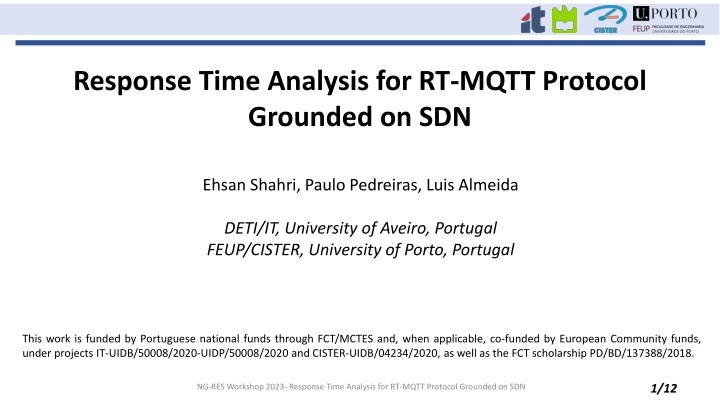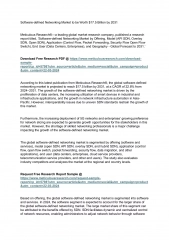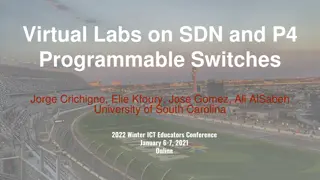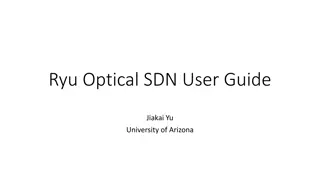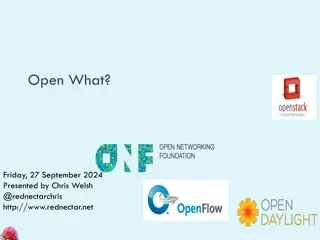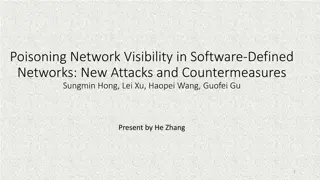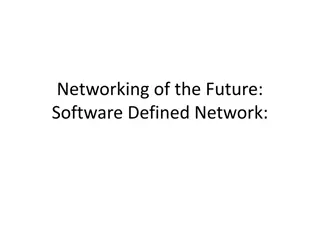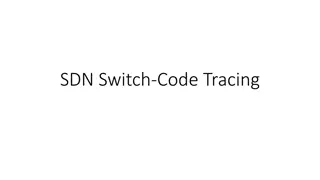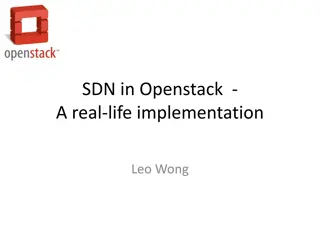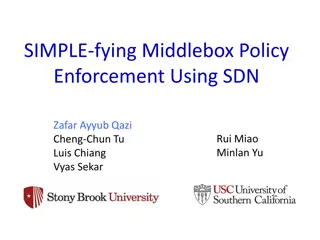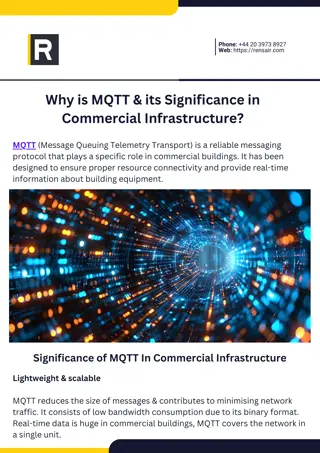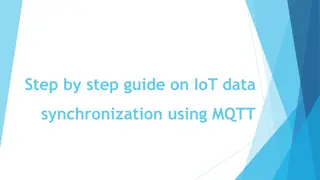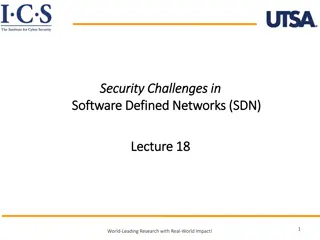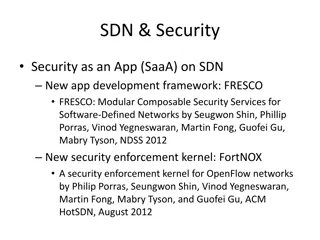Response Time Analysis for RT-MQTT Protocol Grounded on SDN
Industry 4.0 and IIoT in Industrial Operations demand timing behavior, predictability, and stability. This work focuses on analyzing response time for the RT-MQTT protocol based on SDN architecture, addressing real-time requirements. The study formalizes the RT-MQTT system model and demonstrates worst-case communication behavior analysis using fixed-priority non-preemptive scheduling.
Download Presentation

Please find below an Image/Link to download the presentation.
The content on the website is provided AS IS for your information and personal use only. It may not be sold, licensed, or shared on other websites without obtaining consent from the author.If you encounter any issues during the download, it is possible that the publisher has removed the file from their server.
You are allowed to download the files provided on this website for personal or commercial use, subject to the condition that they are used lawfully. All files are the property of their respective owners.
The content on the website is provided AS IS for your information and personal use only. It may not be sold, licensed, or shared on other websites without obtaining consent from the author.
E N D
Presentation Transcript
Response Time Analysis for RT-MQTT Protocol Grounded on SDN Ehsan Shahri, Paulo Pedreiras, Luis Almeida DETI/IT, University of Aveiro, Portugal FEUP/CISTER, University of Porto, Portugal This work is funded by Portuguese national funds through FCT/MCTES and, when applicable, co-funded by European Community funds, under projects IT-UIDB/50008/2020-UIDP/50008/2020 and CISTER-UIDB/04234/2020, as well as the FCT scholarship PD/BD/137388/2018. 1/12 NG-RES Workshop 2023- Response Time Analysis for RT-MQTT Protocol Grounded on SDN
Introduction Introduction Industry 4.0 and IIoT in Industrial Operations: Improvements: scalability, transparency, agility, flexibility and efficiency Requirements: timing behaviour, high predictability and stability Why MQTT? It is a most popular application-layer protocol in (I)IoT applications: Simplicity, low footprint and scalability Effective publisher-subscriber capability MQTT Limitation: It misses support for real-time behaviour 2/12 NG-RES Workshop 2023- Response Time Analysis for RT-MQTT Protocol Grounded on SDN
Contribution Contribution Previous work: RT-MQTT Protocol It extends MQTT with real-time services: Allowing applications to define real-time requirements Translating to network reservations using SDN Contribution of this work: We first formalize RT-MQTT system model We show RT-MQTT worst-case communication behaviour is analysable Using fixed-priority non-preemptive scheduling 3/12 NG-RES Workshop 2023- Response Time Analysis for RT-MQTT Protocol Grounded on SDN
Network Architecture Network Architecture RT-MQTT architecture comprises IoT nodes MQTT broker RT-NM OF-DB OF-Controller OF-Switches RT-MQTT MQTT 4/12 NG-RES Workshop 2023- Response Time Analysis for RT-MQTT Protocol Grounded on SDN
System Model System Model Message Model RT-MQTT classifies traffic flows in non-real-time and real-time Real-time traffic model: Sub MQTT Broker Pub Sub Scheduling Model: A non-preemptive fixed priority scheduling with FIFO strategy is used The generated delays in the network are categorized in two types: Blocking delay Interference delay We use the analyses of R.I.Davis and A.Burns, 2008 5/12 NG-RES Workshop 2023- Response Time Analysis for RT-MQTT Protocol Grounded on SDN
Performance Assessment Performance Assessment Emulation Scenario (Mininet VN emulator): Response times are measured for a set of MQTT messages Two network topologies are considered: Single-Switch and Dual-Switch Three load-levels are investigated: A (5 pubs), B (10 pubs), and C (20 pubs) Heterogeneous data are exchanged (real-time and non-real-time) Single-Switch network topology. Dual-Switch network topology. 6/12 NG-RES Workshop 2023- Response Time Analysis for RT-MQTT Protocol Grounded on SDN
Emulation Setup Emulation Setup Properties of the Real-Time traffic Periods in [2 15] ms Single packet messages with size 1500 bytes Non-real-time traffic TCP packets using D-ITG (Distributed Internet Traffic Generator) Audio/video streams using VLC media player Files (based on File Transfer Protocol (FTP)) using vsftpd Each combination was executed 1000 times With each publisher generating 100 messages per run 7/12 NG-RES Workshop 2023- Response Time Analysis for RT-MQTT Protocol Grounded on SDN
Performance Assessment Performance Assessment Measurement points in the experiments are shown for: Single-Switch Dual-Switch 2 hops 3 hops Response time in the Single-Switch topology Response time in the Dual-Switch topology 8/12 NG-RES Workshop 2023- Response Time Analysis for RT-MQTT Protocol Grounded on SDN
Experimental Results Experimental Results Analytical (CalcRT) versus observed (ExpRT) WCRT for Single-Switch topology 2 hops, light load (A) 2 hops, mid load (B) WCRT 2 hops, high load (C) WCRT 9/12
Experimental Results Experimental Results Analytical (CalcRT) versus observed (ExpRT) WCRT for Dual-Switch topology 3 hops, light load (A) 3 hops, mid load (B) WCRT 3 hops, high load (C) WCRT 10/12
Experimental Results Experimental Results Comparing Analytical (CalcRT) versus observed (ExpRT) WCRT CalcRT / ExpRT Light load (A) Mid load (B) High load (C) Max ratio: 1.69 Min ratio: 1.01 Max ratio: 1.45 Min ratio: 1.04 Max ratio: 1.10 Min ratio: 1.03 2 hops (1 switch) Max ratio: 1.49 Min ratio: 1.12 Max ratio: 1.32 Min ratio: 1.11 Max ratio: 1.29 Min ratio: 1.10 3 hops (2 switches) CalcRT / ExpRT > 1 Architecture respects the analysis Pessimism is tight for high priority messages and generally decreases with load level 11/12 NG-RES Workshop 2023- Response Time Analysis for RT-MQTT Protocol Grounded on SDN
Conclusion Conclusion RT-MQTT is an extension of MQTT with real-time services based on SDN An existing response time analysis is applied to RT-MQTT: Assumes non-preemptive fixed-priority scheduling of sporadic messages Enforced by the multi-hop SDN/OpenFlow switched network Focuses on the worst-case response time of the real-time traffic We carried out validation experiments with heterogeneous traffic Used the Mininet emulator with two topologies and 3 load levels Generated heterogeneous traffic for 1000 times Observed WCRT was always below Analytical WCRT Pessimism varied with an average rate between 1.11 and 1.36 In future work we will consider the end-to-end delay (+broker +end nodes) 12/12 NG-RES Workshop 2023- Response Time Analysis for RT-MQTT Protocol Grounded on SDN
